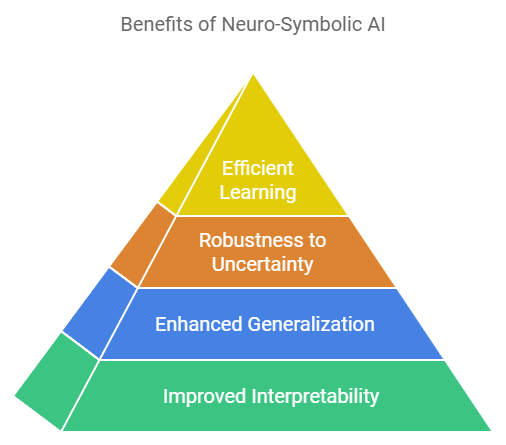Neuro-Symbolic AI: Merging Neural Networks and Symbolic Reasoning for a Smarter Future
What if machines could not only learn patterns from data but also reason like humans? That’s the promise of Neuro-Symbolic AI, a field that…

What if machines could not only learn patterns from data but also reason like humans? That’s the promise of Neuro-Symbolic AI, a field that combines the best of neural networks and symbolic reasoning. But how exactly does this hybrid approach work? And why does it matter so much now?
To understand neuro-symbolic AI, we need to break it down, starting with the core elements: neural networks and symbolic reasoning. After exploring both, we’ll see how this blend offers a new, more efficient way to tackle complex problems that neither approach could handle alone. Finally, we’ll examine its potential, touching on Large Language Models (LLMs) and where this technology might lead us.
Neural Networks: The Power Behind Data Learning
Neural networks are all about learning from raw data. Inspired by the human brain, they consist of layers of interconnected nodes (or neurons) that process and transform data. Neural networks excel in tasks like image recognition, speech processing, and even natural language understanding.
What makes neural networks so effective is their ability to handle raw data directly — without the need for manual feature engineering. Whether it’s text, images, or numerical data, neural networks can absorb vast amounts of unstructured data and automatically learn the relationships within it. For example, when training a neural network to recognize cats in images, you don’t need to tell the system what a cat looks like. It gradually learns from the data, recognizing the complex relationships between pixels, shapes, and colors that form a cat image.
But neural networks also have limitations. They’re great at pattern recognition but terrible at reasoning. While they can make accurate predictions, they can’t explain how or why they came to those conclusions. This is where symbolic reasoning comes in.
Symbolic Reasoning: The Logic Layer
Symbolic AI, often called good old-fashioned AI (GOFAI), represents knowledge using symbols and rules, much like human logic. Instead of learning from raw data, symbolic reasoning relies on predefined facts, rules, and relationships. It allows a machine to use logic and structured knowledge to reach decisions, similar to how humans would follow a set of instructions.
For example, imagine you have a symbolic AI system designed to solve a logic puzzle. You feed it rules like “If A is true, and B is false, then C must be true.” The system processes these rules and facts and makes decisions based on logic, not data patterns. This kind of reasoning is ideal for structured problems where clear rules govern the relationships between variables.
The key strength of symbolic reasoning is its transparency. Unlike neural networks, which function as black boxes, symbolic systems can easily explain their decision-making processes. But these systems struggle with flexibility. They need precise input, and they don’t handle uncertainty or noisy data very well.
The Limits of Both Approaches
Neither approach is perfect on its own. Neural networks can process and learn from unstructured data, but they can’t reason explicitly or explain their actions. Symbolic AI can reason logically but can’t learn from the messy, unstructured world of data.
In real-world applications, this divide becomes a serious limitation. Imagine developing an autonomous vehicle. Neural networks can handle visual data, recognizing pedestrians and street signs, but they might fail to make consistent, rule-based decisions in unexpected situations (like when multiple rules contradict each other). Symbolic reasoning systems, on the other hand, can reason about traffic laws, but they don’t perform well when processing massive amounts of visual data from the car’s sensors.
That’s where neuro-symbolic AI comes in. This hybrid approach blends the strengths of both methods, offering a way for machines to learn from data and reason logically.
How Neuro-Symbolic AI Works
Neuro-symbolic AI doesn’t force you to choose between learning and reasoning. Instead, it integrates neural networks’ learning abilities with symbolic AI’s reasoning capabilities to create a system that’s both adaptable and explainable.
There are several ways to combine these methods, but the basic idea remains the same: use neural networks to handle data perception and symbolic reasoning to make sense of it.
Here’s a simple analogy: think of neural networks as the eyes and ears of an AI system, constantly learning patterns from the environment. Symbolic reasoning acts as the brain, making logical decisions based on those patterns. The result is a system that not only understands the world through data but can also reason about it using logic.
Example: Visual Question Answering (VQA)
Take the case of Visual Question Answering (VQA). In a VQA task, a system receives an image and a question like, “What color is the ball?” The system has to look at the image, understand it, and provide an answer. A purely neural approach might struggle because it doesn’t “understand” the concept of colors in a logical way. A purely symbolic system might fail because it doesn’t handle the raw image data well.
In a neuro-symbolic system, a neural network first processes the image to detect objects and features (like identifying a ball and its color). Then, a symbolic reasoning component uses that structured information to logically answer the question, linking the visual data with the rules about colors and objects.
This combination results in more accurate and explainable outcomes.
The Relationship Between Neuro-Symbolic AI and LLMs
Large Language Models (LLMs) like GPT and BERT have revolutionized natural language processing (NLP). They rely heavily on neural networks to process vast amounts of text data, identifying patterns and relationships between words, sentences, and ideas. These models excel at generating human-like text and answering questions based on patterns they’ve learned from their training data.
But LLMs also have some of the same limitations as neural networks: they’re powerful at learning patterns, but they can’t reason explicitly. They might generate an answer that sounds correct but lacks logical consistency.
Imagine asking a neural network-driven LLM a legal question. It could generate a plausible answer based on the language patterns in its training data, but it wouldn’t be able to apply legal rules and logic effectively. This is where neuro-symbolic approaches could play a big role in the future of LLMs.
By integrating symbolic reasoning with the pattern recognition of neural networks, LLMs could evolve into systems that not only generate plausible text but also apply logical reasoning to their outputs. This hybrid system could improve the accuracy and explainability of LLMs, making them better suited for applications where logic and rules matter — like legal advice, medical diagnostics, or financial planning.
Case Study: IBM’s Project Debater
A well-known example of neuro-symbolic AI in action is IBM’s Project Debater. This AI system can engage in live debates with humans on a variety of topics, offering well-reasoned arguments supported by facts.
Neural networks handle the unstructured data (the vast amounts of text from various sources that Project Debater learns from). The system can sift through thousands of articles, speeches, and documents to identify relevant information. But the system doesn’t stop there. Once it has gathered the necessary information, symbolic reasoning takes over to structure logical arguments and make sense of the data.
This hybrid approach allows Project Debater to not only understand large volumes of text but also reason through that data to form coherent, logical arguments — just like a human debater would.
Hypothetical Scenario: AI in Healthcare Diagnosis
Now, let’s imagine a future healthcare application powered by neuro-symbolic AI. A patient visits a clinic with a series of symptoms that don’t quite match any well-known disease. A purely neural system might analyze the patient’s data — medical history, genetic markers, and current symptoms — and look for patterns that resemble past cases. But if the data is noisy or incomplete, the system might fail to give a reliable diagnosis.
A neuro-symbolic system could step in to improve this process. First, a neural network would process the unstructured data (like medical images or genetic information), identifying patterns that might suggest possible conditions. Then, the symbolic reasoning component would apply medical rules and guidelines, cross-referencing the patient’s symptoms with established medical knowledge to arrive at a logical diagnosis.
The result? A system that can both learn from data and reason about it, offering a diagnosis that is both informed by past cases and aligned with medical logic.
Challenges and the Road Ahead
Despite the promise, neuro-symbolic AI is still in its early stages, and several challenges remain. One of the biggest hurdles is integrating these two very different methods — getting neural networks and symbolic systems to work together seamlessly is no small feat. Another challenge lies in scaling neuro-symbolic systems to handle the massive amounts of data required for real-world applications.
Still, the potential is enormous. Neuro-symbolic AI offers a way to overcome the limitations of current AI systems, providing machines that can both learn from raw data and reason logically. Whether it’s in healthcare, law, or even creative industries like art and music, this hybrid approach could help create more intelligent, adaptable, and explainable AI systems.
Neuro-symbolic AI represents the next step in AI’s evolution, blending the learning abilities of neural networks with the logic of symbolic reasoning. By bridging the gap between data-driven learning and human-like reasoning, this approach could unlock new possibilities across various fields.
And as Large Language Models continue to evolve, incorporating symbolic reasoning could take them to a whole new level, making them more accurate and capable of handling complex, rule-based reasoning. While the road ahead is challenging, the potential benefits make neuro-symbolic AI one of the most exciting areas of research today.
If you like topic like this one, follow me, I publish regularly on Medium.


